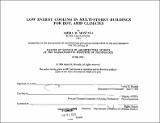Low energy cooling in multi-storey buildings for hot, arid climates
Author(s)
Mostafa, Amira M
DownloadFull printable version (7.998Mb)
Alternative title
Low energy cooling in multi-story buildings for hot, dry climates.
Other Contributors
Massachusetts Institute of Technology. Dept. of Architecture.
Advisor
Timothy Johnson.
Terms of use
Metadata
Show full item recordAbstract
This thesis discusses passive and low energy cooling strategies and systems in hot arid climates. The choice of a certain strategy, as well as determining the appropriate cooling schemes for such a context becomes of prime importance in developing the optimum energy conscious building design. The motivation for working in this area of research stems for the need facing architects to start developing a serious sense for energy considerations in their architectural design, especially in existing and multi-storey buildings. Here, in this research, the different factors that govern the control of heat gain through the envelope of the building will be analyzed. Also, solutions to minimize the cooling load for dwellings will be suggested/provided; by means of selecting the adequate cooling systems (evaporative, convective, and radiative) that promote the optimum desired thermal comfort. This research concludes its technical analysis with an architectural design for two schemes; The first is a cooling system that can be applied to new buildings, or retrofitted to existing ones. It uses evaporative coolers and solar chimney systems at daytime. It also uses night-time forced ventilation to cool the ordinary slab. The second can be applied in new buildings. It uses evaporative coolers and solar chimney systems at day-time. It also uses night-time forced ventilation through cored slabs. This design, and these schemes, are perceived as a starting point for further development and more research.
Description
Thesis (M.S.)--Massachusetts Institute of Technology, Dept. of Architecture, 1989. Includes bibliographical references (leaves 122-125).
Date issued
1989Department
Massachusetts Institute of Technology. Department of ArchitecturePublisher
Massachusetts Institute of Technology
Keywords
Architecture.